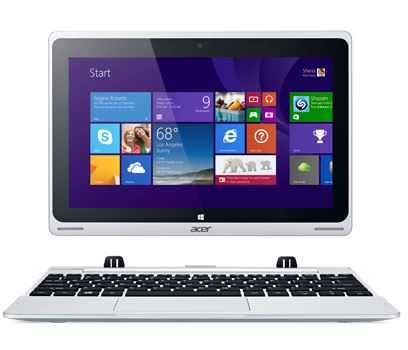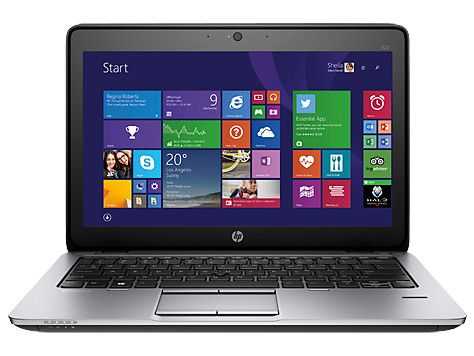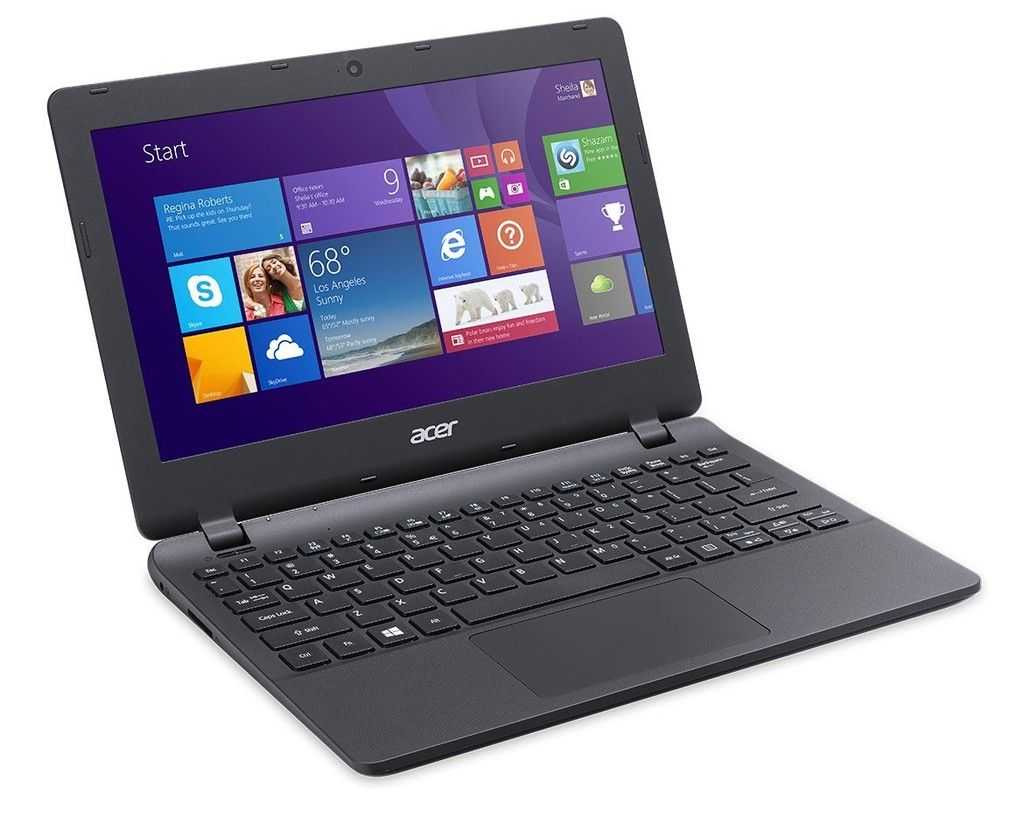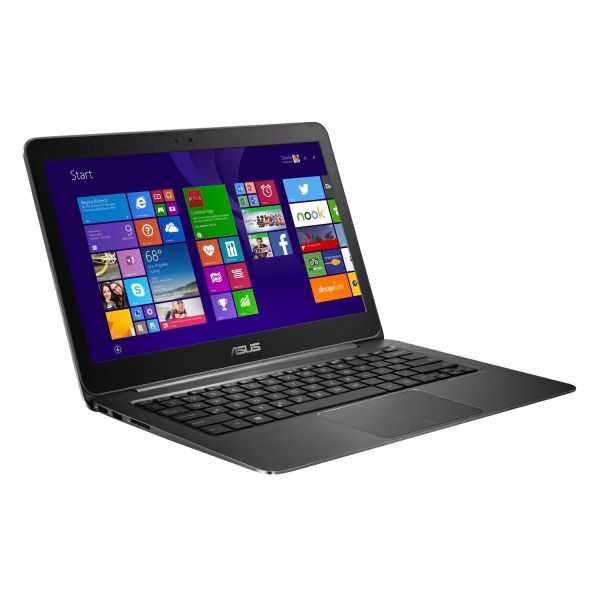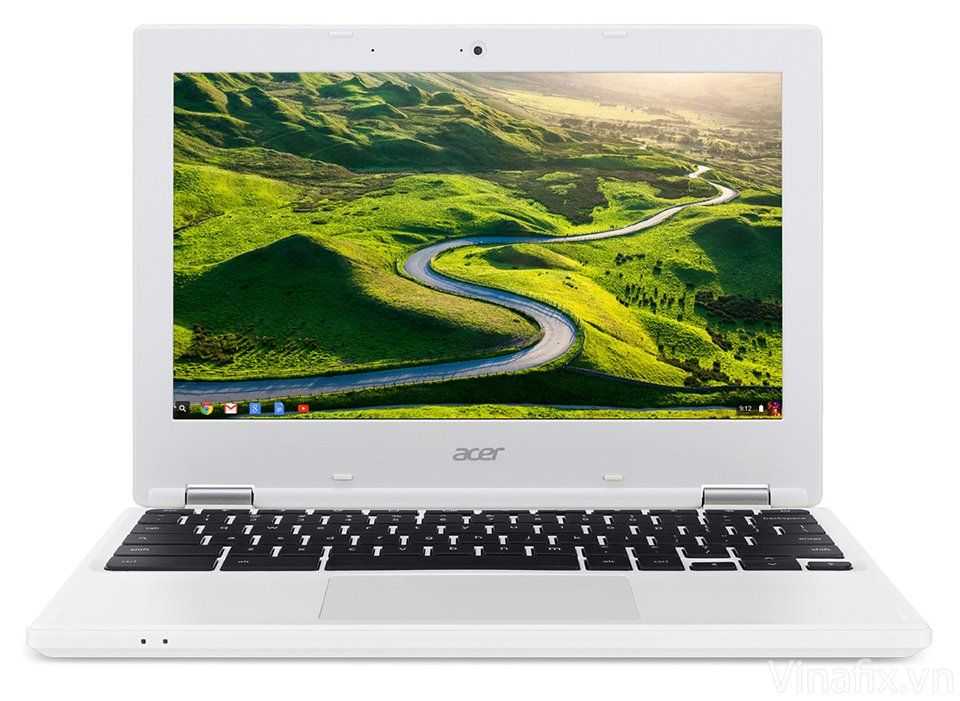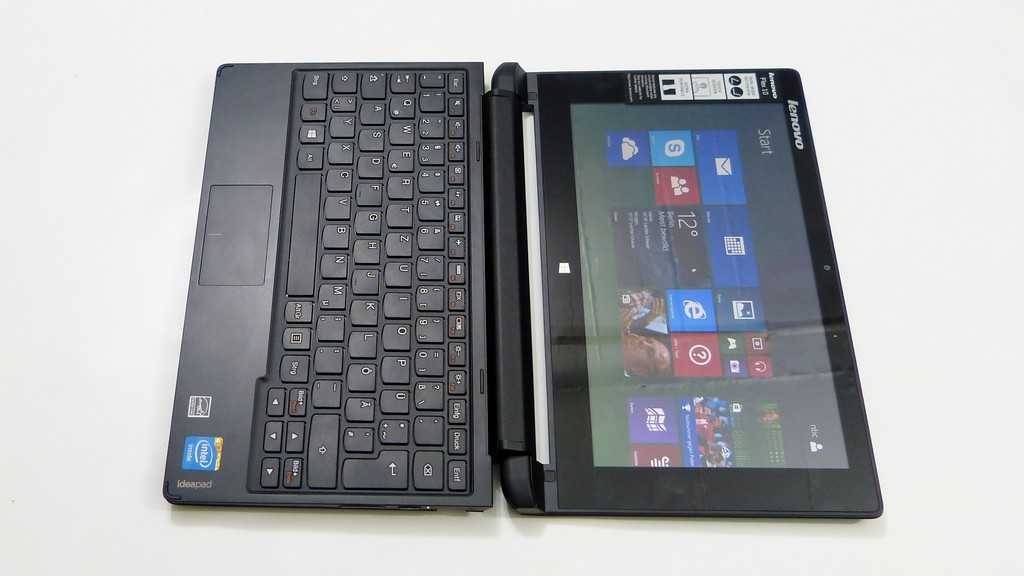
Posted on 31 August 2007
Distance since last post: 75km
Weather: Cloudy, rainy.
Forecast: Bad for the next 3-days. Looks like I’ll have to be careful!
Notes: Crashed into a lamppost while I was trying to mount my bike. No damage. Phew!
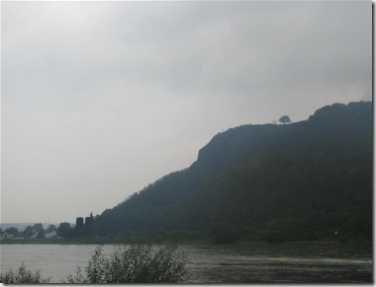
View towards Remagen (two bridge towsers can be seen at base of hill) in terrible weather.
No sun, no energy although somehow I’m managing to squeeze enough out of the clouds to charge the phone which is pretty amazing. Luckily I have enough juice on the UMPC battery and the Li-Ion battery to give me about 4 hours of computing. If I spot any sun at all over the next 3 days I’ll have to stop and sap up as much as I can. Its going to be very tight. Will I have enough left for the final report in Duesseldorf?
Right now I’m in Bonn and at home with my wife. I’m only using battery power and won’t be charging anything so there’s no change to the plan. Apart from a long bath and a good sleep tonight ready for the last two legs on Saturday and Sunday.

Posted on 30 August 2007
When I did my first tests and calculations about the use of solar power to drive a PC I was quite amazed at the inefficiency of the process and today’s ‘laboratory conditions’ test proves just how much room for improvement there is. It’s thanks to devices like UMPCs that this is project is at all possible because I really doubt it would have worked with even a ‘power saving’ notebook PC.
Today I stayed at the campsite and put the Solar panel and Li-Ion battery through a 3 hours test. Its was a cloudless day with a very thin haze, 22 degrees centigrade and for reference I’m located at about 50 degrees north and 7 degrees east. The date is the 30th of August which is heading towards Autumn here in Germany. The test was done from 11:00 – 14:00 and I took the empty Li-Ion battery and charged it with the solar panel for 3 hours.
I estimate that about 1.2KW of energy hit my 7000 cm2 panel with about 660W falling on the Solar cells (3500 cm2). After conversion to electricity it created about 50w/hr of energy. Of that, about 40W was taken by the Li-Ion battery because it only uses a fixed current and voltage. It won’t adapt to the power available. Due to input voltage conversions and charging losses, this left me with an estimated 30W of energy and after taking this through yet another set of voltage conversions and charging process, left me with a rather poor 18W of power. Of course this is enough for a few hours of work but isn’t it incredible that so much power is wasted (or rather passed back as heat!)
I spent the rest of the afternoon trying to work out how this process could be improved and I’ve come up with a list of ideas that could help. I’ll talk though them in the next post but right now I need to put some more cream on the back of my legs because through all the concentration I forgot about the sun and I’ve burned the bit right behind the knee. That’s going to be really enjoyable tomorrow when I make the 70km dash to Bonn.
Here’s a diagram I created quickly on the Q1b. Hopefuly it makes things a bit clearer. How would you improve the architechture?
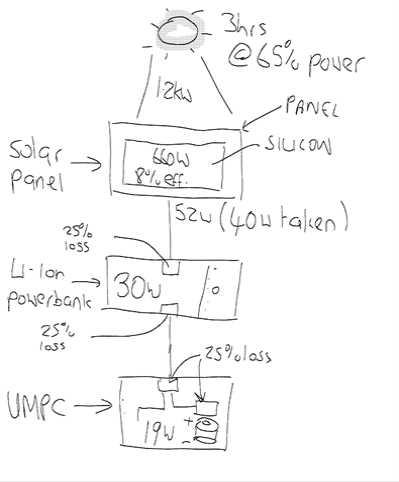

Posted on 28 August 2007
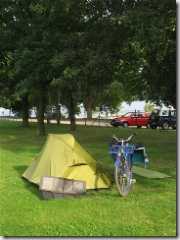 Distance since last post: 15km
Distance since last post: 15km
Weather: Clouds thinning
Notes: I don’t have much faith in the lead-acid battery. The Li-Ion battery seems to be charging much more reliably.
Another day completed and I feel like I’m getting into a better rhythm. Checking emails and RSS on the mobile phone and creating rich journal updates with the Q1b. I only wish I had a mind recorder because I’m thinking of some great ideas while I cycle but forgetting them when I get to a point where I could write them down!
The bike, which I’ve decided to call Berta (the Blue Bakers Bike) is performing fantastically well. I was a bit worried about having no gears but the fixed gear ratio is perfect for around 22km/h which, with 65KG of pack on a 25KG bike is just perfect. The thick tyres help to soak up bumps and now that I’ve pumped up the pressure a bit more, seem to roll without too much resistance. I even clocked 34kn/h on a straight today . Wohoo! Berta is Berta
Read the full story

Posted on 28 August 2007
Distance since last post: 40km
Weather: Mixed, cloudy. Hazy. Warm 20-22 degrees
Notes: Feeling really good. No aches. Pushing harder today. Cant stop eating sultanas! The hills on each side of the Rhein are getting bigger!
Winter is coming…If you take notice of the geese that is. I saw a flock flying south (following the River perhaps) this morning and wondered if they knew something that I didn’t. Its was lovely and warm yesterday and its pretty much the same today. Is there some nasty weather around the corner or did they get an SMS from some Geese mates in Africa telling them to come early?
Although its been warm its been very cloudy today. Much cloudier than yesterday and yet I still managed to get some charge into the Li-Ion battery and (I think) something into the lead-acid battery. Despite that though I’m using my spare battery and thinking carefully how to use the UMPC more efficiently. Daytime use (like now!) is not the best as the backlight needs to be turned right up. That’s draining an extra 2 watts compared to evening use when I can drop the backlight to minimum.
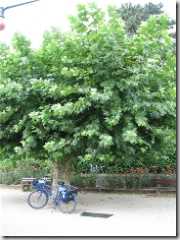 I felt very strong this morning and powered the 85KG bike/baggage combo through to Mainz in much less time than I had planned. It was really enjoyable. While the clouds where thick I kept on cycling and ended up in Eltville where the was a lovely Rhein terrace restaurant serving Spargel Suppe (Asparagus Soup.) I stayed for an hour while the solar panel and bike rested by a tree and then layed myself down on a bench for an after-lunch nap. After buying, writing and sending a few postcards I carried on the journey. The Rhein-side path was pretty bumpy and at every chance I tried to find another route but this was really the only sensible offering, the other being a trek up to the hills! Then, after about ten minutes I heard a crash behind me and stopped as quickly as I could. I looked back to see the battery packs and cables strewn across the path along with the shattered container. Shit! I gathered it all together, repacked it and then checked everything out.I think I’ve been lucky. Everything seems to be working still so I think it was just a warning from above to tell me not to take afternoon naps!
I felt very strong this morning and powered the 85KG bike/baggage combo through to Mainz in much less time than I had planned. It was really enjoyable. While the clouds where thick I kept on cycling and ended up in Eltville where the was a lovely Rhein terrace restaurant serving Spargel Suppe (Asparagus Soup.) I stayed for an hour while the solar panel and bike rested by a tree and then layed myself down on a bench for an after-lunch nap. After buying, writing and sending a few postcards I carried on the journey. The Rhein-side path was pretty bumpy and at every chance I tried to find another route but this was really the only sensible offering, the other being a trek up to the hills! Then, after about ten minutes I heard a crash behind me and stopped as quickly as I could. I looked back to see the battery packs and cables strewn across the path along with the shattered container. Shit! I gathered it all together, repacked it and then checked everything out.I think I’ve been lucky. Everything seems to be working still so I think it was just a warning from above to tell me not to take afternoon naps!
Only about 20km to go until the campsite and having looked closely at my plan, it appears that I’m ahead in terms of distance but behind in terms of energy capture. I need to take longer breaks. But no afternoon naps!!

Posted on 27 August 2007
Location: Oppenheim
Distance since last post: 68Km
Weather: Hot with 50% cloud cover
Forecast: Heavier cloud tomorrow. Clearing toward Thursday.
Notes: Problem with the Lead-acid battery today. It didn’t seem to charge. Will concentrate on loading the Li-Ion battery tomorrow.
 Due to the cloudy weather I decided to cycle all the way through to the campsite in one stage today. I chose a route slightly away from the Rhein which had the advantage of being more direct but the disadvantage of being inland and therefore higher. Hills are not something I enjoy on the 25KG Kronan bike! The route was nice though and it took me through endless lines of grape vines (and loud, gun-like bird scarers going off every ten seconds all over the valley) that are almost ready for harvesting for wine. Every town and village seems to be advertising their Winzer (Wine) Fest!
Due to the cloudy weather I decided to cycle all the way through to the campsite in one stage today. I chose a route slightly away from the Rhein which had the advantage of being more direct but the disadvantage of being inland and therefore higher. Hills are not something I enjoy on the 25KG Kronan bike! The route was nice though and it took me through endless lines of grape vines (and loud, gun-like bird scarers going off every ten seconds all over the valley) that are almost ready for harvesting for wine. Every town and village seems to be advertising their Winzer (Wine) Fest!
The mobile phone I have is doing very well as my email notifier and as (filtered) emails come in I get a little beep telling me to stop and take a look. Its nice to be able to say I’m in the middle of a Vineyard’ at the end of each reply! But that’s about it for the mobile phone. Trying to do anything Web-like is slow and terribly inefficient. Firing up the Q1b UMPC every now and then keeps proving how perfect they are for Internet activities. There’s no way I would be able to write so quickly, create the maps, review and edit the images and communicate via IM through all the protocols possible without it.
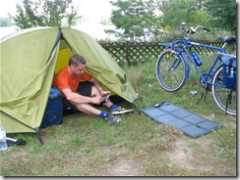 I’m camped right next to a beach on the Rhein (that’s the Rhein behind me there!) and can hear the waves lapping against the shore. Every 10 or 15 minutes a huge river boat can be heard either coming down from Rotterdam or heading up from the south somewhere. Fuel, sand, containers and even the occasional passenger boat. The Rhein is a business river. I wonder how long it remains efficient compared to trains, trucks and air transport.
I’m camped right next to a beach on the Rhein (that’s the Rhein behind me there!) and can hear the waves lapping against the shore. Every 10 or 15 minutes a huge river boat can be heard either coming down from Rotterdam or heading up from the south somewhere. Fuel, sand, containers and even the occasional passenger boat. The Rhein is a business river. I wonder how long it remains efficient compared to trains, trucks and air transport.
I haven’t planned tomorrow in detail but it won’t be as long a journey as today. The Lead-Acid battery I have (2.2KG worth of old technology) didn’t charge well and so I’ll concentrate on loading-up the Li-Ion battery. One bit of good news though is that the mobile phone charges from the solar panel even in bright daylight. If all else fails I’ll have to email the blogs via T9 but I hope that doesn’t happen. I still have a fully charged spare battery for the Q1b so I’m not in trouble yet!

Posted on 11 July 2007
Here’s a solution based on the Sunlinq 25w panel and a Xantrec 300 Plus combo lead-acid battery/inverter. Its very similar to my own solution apart from the fact that this one weighs nearly 10KG!!!
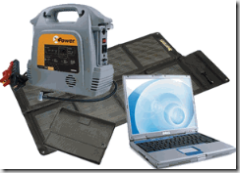
A number of blogs seemed to have picked up on this solution today and are quoting 11-12 hours charging time. This figure is a little misleading. The battery capacity is about 240w/hr and based on a reasonable 5-hour per day full-sun rate its going to take 10 hours. That’s a minimum of 36 hours duration! In middle-Europe, you’ll be waiting for 3 full days of sun!
The other point to consider is that you need to take all your AC converters with you (weight problem) and should recon on 20% energy loss by converting from 12v -> 110V and down to 12, 16, 19 or whatever voltage your device takes. Hardly efficient. Alternatively you can buy 12v car adaptors for all your equipment (can get expensive.)
My recommendation is to use a combination of a Li-ion battery with variable DC output (I’m using the TabletKiosk/Tekkeon MP3400) and a lead-acid battery (I’m using a 2.5kg 6Ah part) This gives you the best of both worlds (lead-acid flexibility and Li-Ion light weight) and cuts the total weight right down to under 4KG. At also avoids having to operate a dangerous 110v. Capacity with my solution is around 130W/hr but here’s the key. Don’t use a notebook PC, use a UMPC. They are far more efficient. With a normal UMPC you’re good for 10 hours of computing on a fully charged system (around 7 hours full-sun charge time.)
News Via GottaBeMobile.

Posted on 27 June 2007
I don’t really understand why I didn’t try this before. Its simple. its recommended and it works. Have I been too focused on flexibility why simplicity could be the answer?
I was speaking to Chris from Euro-Line, an importer of consumer solar products and he highlighted a document that I’d already seen. I took another look and staring me in the face was a recommended and tested solution using equipment that I already have. Its the same setup that I tested with the P3 panel. Just plug the panel into the Tekkeon MP3400 and wait for enough sun. You might remember back in the early posts that this is how I found out that Li-Ion charging solutions where not so efficient and how it set me on the path to research a more flexible solution.
With the ’12v’ 25w Sunlinq panel I have I assumed that a 12V output wouldn’t drive a 19v input and after looking at the diagram again I though ‘why are they recommending this solution? It shouldn’t work.’
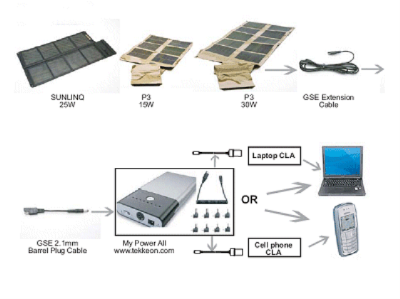
Image taken from GlobalSolar.com PDF here.
Looking more closely at the specs of the panel, its clear now why it works. The 12 panel isn’t strictly 12V. The voltage varies according to the load and in fact with an open circuit the voltage is way up over 20 volts. However, with a load of around 800mA, the charging current for the power bank, the voltage sits nicely at around 20V. Tada!
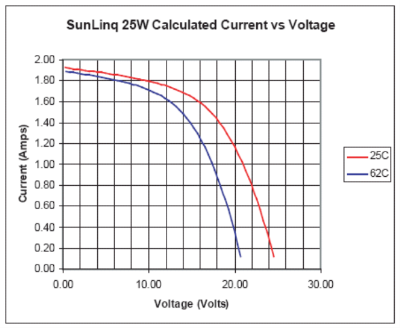
With a 25W panel, 800ma at 19V is reached at around 60% sun power. On a clear summer day here, the sun is over 60% power for around 5 hours between 11 and 4pm. The charger needs 4 hours to load up 56W of energy.
Now here’s an idea. Between 12 and 2, the panel is producing 40% more energy than the Li-Ion battery is taking. Can I mop that up with a lead-acid battery?
Testing continues…

Posted on 27 June 2007
In a recent comment here, someone asked why the Lead-Acid battery was needed. Its probably not too clear in the video why I use it so I reproduce my answer (which comes from the best of my knowledge!) here.
There are two main problems with charging Li-Ion batteries from Solar panels.
Firstly, Li-Ion batteries (in notebooks and battery bank) charge using a constant current (stream) of power. For common notebook batteries and battery banks such as the Tekkeon MP3400, this is around 1A. A lot of the 12V portable solar panels only reach this power at high sun levels meaning you can only use them for a few hours mid-day. In fact a 12W panel might not be enough to even start the charging process. Secondly, if you have a huge panel that could deliver, say, twice as much power as needed, its not used. Only the power needed is taken. The rest is wasted.
These two problems can be overcome at the expense of weight with a lead-acid battery.
L-A batteries are more flexible. You can charge them with a trickle and also with a higher charge rate. They are much more suited to pairing with a solar panel. The problem with this solution is weight. Small 12v L-A batteries are over 2KG in weight!
What’s needed is a flexible Li-Ion battery charging solution. Currently there are no products on the market that can archive this but I’m searching hard!
In summary there are 2 solutions.
1 – Get a panel powerful enough to charge a Li-ion battery at 70% of its rated output. For example, a 25W panel and the Tekkeon MP3400 Li-ion battery. This will give you about 4 hours of charge time on a sunny summer day. (Mid-Europe) This should be enough to completely fill up the Li-ion battery.
2 – Go for a heavier solution with a L-A battery and give yourself more charging flexibility.




 Distance since last post: 15km
Distance since last post: 15km








